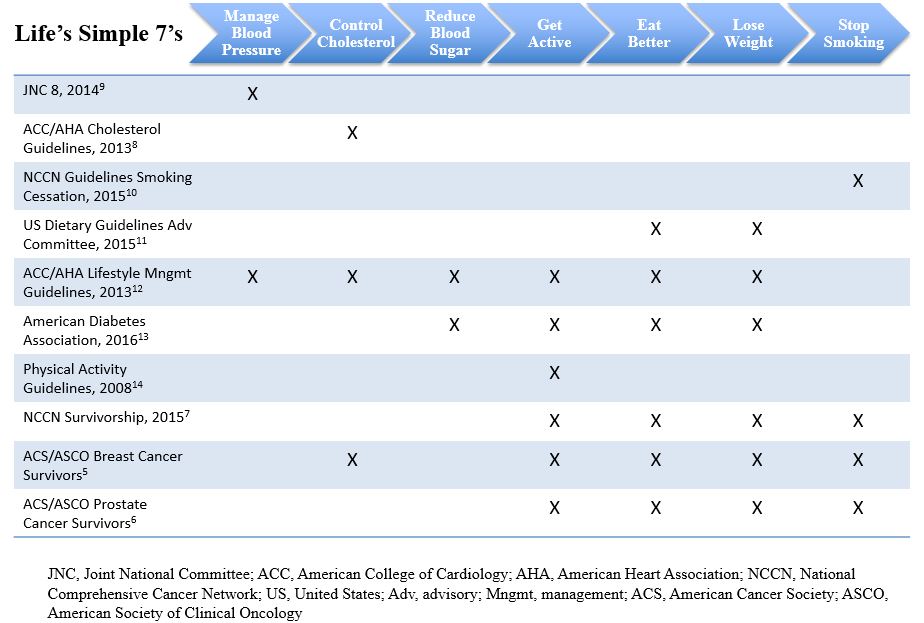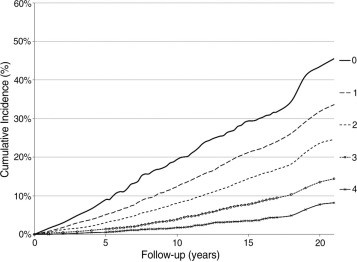Integration of CVD Prevention Into Cancer Survivorship
Introduction
The American Cancer Society predicts that by 2024, there will be 19 million long-term survivors of cancer in the United States.1 Cardiovascular disease (CVD) is the leading cause of death in many survivors of cancer, and cardiovascular risk factors are more prevalent compared with age-matched controls.2,3 Survivors of cancer are therefore a rapidly growing, high-risk population with increasing but still relatively under-focused preventative efforts. Because CVD in survivors of cancer shares the same underlying pathophysiological mechanisms as the general population, the same interventions apply. Recognition of increased risk and modification of traditional risk factors remains the most effective strategy for primary prevention in this population.
An Important Transition to Survivorship
Clinicians caring for patients with cancer are familiar with the concept of competing risks whereby therapies aimed at combating cancer are weighed against the potential for adverse outcomes from other diseases. As patients with cancer enter long-term survivorship (generally defined as >5 years from diagnosis), the risk of death from CVD rivals, and in many cases exceeds, that of recurrent or de novo cancer. This period is an important time for CVD prevention whereby primary care efforts move to the foreground, with many patients transitioning back to traditional primary care settings and some patients continuing with their oncologist. This transition represents a logistically difficult but critically important moment in the care of a survivor of cancer. In 2006, the Institute of Medicine identified the need for a survivorship plan, noting that many patients are lost in this transition.4 Subsequently, survivorship guidelines for those with breast or prostate cancer have been published with prevention of CVD as a prominent focus.5-7
One potential downside to cancer-specific survivorship guidelines as they pertain to CVD prevention is that primary care clinicians may become entangled in the complexities of each cancer's specific treatment effects on CVD (androgen deprivation therapy, for instance) and lose sight of the big picture. Despite the ever-growing armamentarium and complexity of novel cancer therapeutics and well-publicized cardiotoxicities of some of those therapies, the majority of CVD risk for the average survivor of cancer is driven by traditional cardiovascular risk factors. The greatest reduction in risk is likely to be achieved by following primary prevention guidelines created for the general adult population (Table 1).8-14
Table 1
Estimating Risk
The pooled cohort risk equation (http://tools.acc.org/ASCVD-Risk-Estimator/) created for the American College Cardiology (ACC) and American Heart Association (AHA) 2013 Guidelines on the Assessment of Cardiovascular Risk is the most widely used initial tool for risk discussions.15 Elevated risk estimates support treatment decisions, such as the initiation of lipid-lowering therapy but also, perhaps more importantly, frame the provider-patient discussion and prioritize lifestyle changes. Most survivors of cancer would be expected to fall into the intermediate risk (5 to <7.5% 10-year risk of atherosclerotic CVD [ASCVD]) or high risk (≥7.5%) estimates due to age and shared cardiovascular risk factors.
It is important to recognize that risk estimation is based on group averages, which are largely driven by chronological age and may underestimate event rates in certain higher risk individuals, such as survivors of cancer. For survivors of cancer at intermediate risk of ASCVD, the use of risk modifiers such as a family history, estimated lifetime ASCVD risk, low density lipoprotein cholesterol serum levels, high-sensitivity C-reactive protein, coronary artery calcium score, or ankle brachial index may be useful for more accurately refined ASCVD risk estimation (ACC/AHA Class IIb, Level of Evidence C). The most important part of risk estimation, particularly for those for whom a treatment decision is not obvious, is communication of risk and an effective provider-patient discussion on the potential benefit of lifestyle and treatment interventions.
Life's Simple 7
The AHA developed a framework called Life's Simple 7 (Table 1), which includes both ideal health behaviors (nonsmoking, normal body mass index, physical activity at goal levels, and a healthy diet) and ideal health factors (cholesterol <200 mg/dL, blood pressure <120/<80 mm Hg, and a fasting glucose <100 mg/dL).16 Adherence to these factors promotes overall cardiovascular health and lowers the incidence of CVD (Figure 1).17 Results from the ARIC (Atherosclerotic Risk in Communities) study, with a median follow-up of 18.7 years, showed separation of the incident CVD curves within the first 5 years (Figure 2). It is then reasonable to infer that survivors of cancer with a life expectancy of at least 5-10 years would be expected to benefit from adopting Life's Simple 7.
Figure 1
Figure 2
There is concern that many of these metrics are absent or underemphasized in survivors of cancer. Patients with cancer in the Community Southern Cohort had a median of 3 healthy behaviors with only 0.9% achieving 6-7, compared with 1.7% in controls without cancer (p < 0.001).18 An analysis of survey data in 2007 revealed that more the majority of survivors of cancer did not report discussions on diet (30%), smoking (42%), or exercise (26%).19 As emphasized in numerous guidelines (Table 1), CVD prevention begins with effective discussions on lifestyle changes. With an ever-greater emphasis on value and efficiency in health care delivery, the quality time for such interactions between provider and patient becomes an increasingly valuable resource. The success of these interactions is critical for integration of primary prevention of CVD into cancer survivorship.
Collateral Benefits
The benefit of adherence to Life's Simple 7 extends beyond CVD prevention and may decrease the incidence of cancer. An analysis from the ARIC study showed a 51% relative risk reduction of incident cancer for those with 6-7 healthy metrics.20 Such findings reinforce the concept that cancer and CVD are not necessarily competing risks but are both driven by shared risk factors. Modifying these shared risk factors may jointly attenuate the top two causes of death in Western society.
Conclusions
The transition to long-term survivorship of cancer is a cause for celebration but poses risk for a myopic focus that fails to account for long-term health risks beyond cancer such as CVD. Integrating CVD prevention efforts is important to preserve the health won back from cancer. Modification of traditional risk factors via the application of primary prevention guidelines will likely attenuate risk more than specific efforts directed toward individual cancers. Such recommendations are easier to digest and assimilate for primary care providers who are often unfamiliar with the details of cancer therapies.
There is evidence that adherence to healthy behaviors and factors may reduce the risk of both CVD and cancer. This concept underscores the benefit of partnership between cardiology and oncology. Coordination between the two groups in both guideline writing and structuring of the survivorship stage will go a long way in improving the prevention of CVD in survivors of cancer.
References
- American Cancer Society. Cancer Treatment and Survivorship Facts & Figures 2014-2015. Atlanta: American Cancer Society; 2014.
- Weaver KE, Foraker RE, Alfano CM, et al. Cardiovascular risk factors among long-term survivors of breast, prostate, colorectal, and gynecologic cancers: a gap in survivorship care? J Cancer Surviv 2013;7:253-61.
- Patnaik JL, Byers T, DiGuiseppi C, Dabelea D, Denberg TD. Cardiovascular disease competes with breast cancer as the leading cause of death for older females diagnosed with breast cancer: a retrospective cohort study. Breast Cancer Res 2011;13:R64.
- Institute of Medicine and National Research Council (Hewitt M, Greenfield S, Stovall E, eds). From Cancer Patient to Cancer Survivor: Lost in Transition. Washington, DC: The National Academies Press; 2006.
- Runowicz CD, Leach CR, Henry NL, et al. American Cancer Society/American Society of Clinical Oncology Breast Cancer Survivorship Care Guideline. J Clin Oncol 2016;34:611-35.
- Skolarus TA, Wolf AM, Erb NL, et al. American Cancer Society prostate cancer survivorship care guidelines. CA Cancer J Clin 2014;64:225-49.
- Ligibel JA, Denlinger CS. New NCCN guidelines for survivorship care. J Natl Compr Canc Netw 2013;11(5 Suppl):640-4.
- Stone NJ, Robinson J, Lichtenstein AH, et al. 2013 ACC/AHA guideline on the treatment of blood cholesterol to reduce atherosclerotic cardiovascular risk in adults: a report of the American College of Cardiology/American Heart Association Task Force on Practice Guidelines. Circulation 2014;129(25 Suppl):S1-45.
- James PA, Oparil S, Carter BL, et al. 2014 evidence-based guideline for the management of high blood pressure in adults: report from the panel members appointed to the Eighth Joint National Committee (JNC 8). JAMA 2014;311:507-20.
- Shields PG. New NCCN Guidelines: Smoking Cessation for Patients With Cancer. J Natl Compr Canc Netw 2015;13(5 Suppl):643-5.
- Marshall TA. Dietary Guidelines for Americans, 2010: an update. J Am Dental Assoc 2011;142:654-6.
- Eckel RH, Jakicic JM, Ard JD, et al. 2013 AHA/ACC guideline on lifestyle management to reduce cardiovascular risk: a report of the American College of Cardiology/American Heart Association Task Force on Practice Guidelines. J Am Coll Cardiol 2014;63(25 Pt B):2960-84.
- American Diabetes Association. Standards of Medical Care in Diabetes-2016 Abridged for Primary Care Providers. Clin Diabetes 2016;34:3-21.
- Physical Activity Guidelines for Americans (Office of Disease Prevention and Health Promotion website). 2008. Available at: https://health.gov/paguidelines/guidelines. Accessed 11/5/2016.
- Goff DC Jr, Lloyd-Jones DM, Bennett G, et al. 2013 ACC/AHA guideline on the assessment of cardiovascular risk: a report of the American College of Cardiology/American Heart Association Task Force on Practice Guidelines. Circulation 2014;129(25 Suppl 2):S49-73.
- Lloyd-Jones DM, Hong Y, Labarthe D, et al. Defining and setting national goals for cardiovascular health promotion and disease reduction: the American Heart Association's strategic Impact Goal through 2020 and beyond. Circulation 2010;121:586-613.
- Folsom AR, Yatsuya H, Nettleton JA, Lutsey PL, Cushman M, Rosamond WD, ARIC Study Investigators. Community prevalence of ideal cardiovascular health, by the American Heart Association definition, and relationship with cardiovascular disease incidence. J Am Coll Cardiol 2011;57:1690-6.
- Singh J, Gupta D, Huang S, et al. The Association of the American Heart Association's Life's Simple 7 with Incident Cancer in the Southern Community Cohort Study. J Am Coll Cardiol 2016:67:1900.
- Sabatino SA, Coates RJ, Uhler RJ, Pollack LA, Alley LG, Zauderer LJ. Provider counseling about health behaviors among cancer survivors in the United States. J Clin Oncol 2007;25:2100-6.
- Rasmussen-Torvik LJ, Shay CM, Abramson JG, et al. Ideal cardiovascular health is inversely associated with incident cancer: the Atherosclerosis Risk in Communities study. Circulation 2013;127:1270-5.
Keywords: American Cancer Society, American Heart Association, Ankle Brachial Index, Blood Pressure, Body Mass Index, C-Reactive Protein, Cardiotoxicity, Cardiovascular Diseases, Cholesterol, LDL, Coronary Vessels, Health Behavior, Life Expectancy, Life Style, Primary Health Care, Primary Prevention, Prostatic Neoplasms, Risk Factors, Smoking, Survival Rate, Survivors
< Back to Listings



